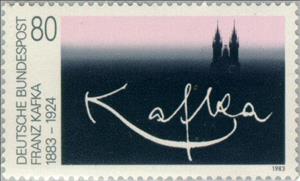Stamp: Kafka, Franz (Germany, Federal Republic 1983)
Kafka, Franz (Germany, Federal Republic 1983)
05 May (Germany, Federal Republic ) within release Brahms, Johannes goes into circulation Stamp Kafka, Franz face value 80 German pfennig
| Stamp Kafka, Franz in catalogues | |
|---|---|
| Michel: | Mi:DE 1178 |
| Stamp Number: | Sn:DE 1395 |
| Yvert et Tellier: | Yt:DE 1010 |
Stamp is horizontal format.
Franz Kafka (1883-1924), Writer: Signature, Tyn church, PragueAlso in the issue Brahms, Johannes:
- Stamp - Brahms, Johannes face value 80;
- Stamp - Kafka, Franz face value 80;
- Stamp - Reinheitsgebot face value 80;
- Stamp - Concord 1683 face value 80;
Stamp Kafka, Franz it reflects the thematic directions:
Famous People refers to the fame and public attention accorded by the mass media to individuals or groups or, occasionally, animals, but is usually applied to the persons or groups of people (celebrity couples, families, etc.) themselves who receive such a status of fame and attention. Celebrity status is often associated with wealth (commonly referred to as fame and fortune), while fame often provides opportunities to make money.
Commemorations are a type of religious observance in the many Churches of the Anglican Communion, including the Church of England. They are the least significant type of observance, the others being Principal Feasts, Principal Holy Days, Festivals, and Lesser Festivals. Whereas Principal Feasts must be celebrated, it is not obligatory to observe Commemorations. They are always attached to a calendar date, and are not observed if they fall on a Sunday, in Holy Week, or in Easter Week. In Common Worship Commemorations are not provided with collects or indications of liturgical colour. However, they may be celebrated as Lesser Festivals if local pastoral conditions suggest it.
A church building, often simply called a church, is a building used for Christian religious activities, particularly worship services. The term in its architectural sense is most often used by Christians to refer to their religious buildings, but it is sometimes used (by analogy) for buildings of other religions. In traditional Christian architecture, the church is often arranged in the shape of a Christian cross. When viewed from plan view the longest part of a cross is represented by the aisle and the junction of the cross is located at the altar area. Towers or domes are often added with the intention of directing the eye of the viewer towards the heavens and inspiring church visitors. Modern church buildings have a variety of architectural styles and layouts; many buildings that were designed for other purposes have now been converted for church use; and, similarly, many original church buildings have been put to other uses. The earliest identified Christian church was a house church founded between 233 and 256. During the 11th through 14th centuries, a wave of building of cathedrals and smaller parish churches occurred across Western Europe. A cathedral is a church, usually Roman Catholic, Anglican, Oriental Orthodox or Eastern Orthodox, housing the seat of a bishop.



